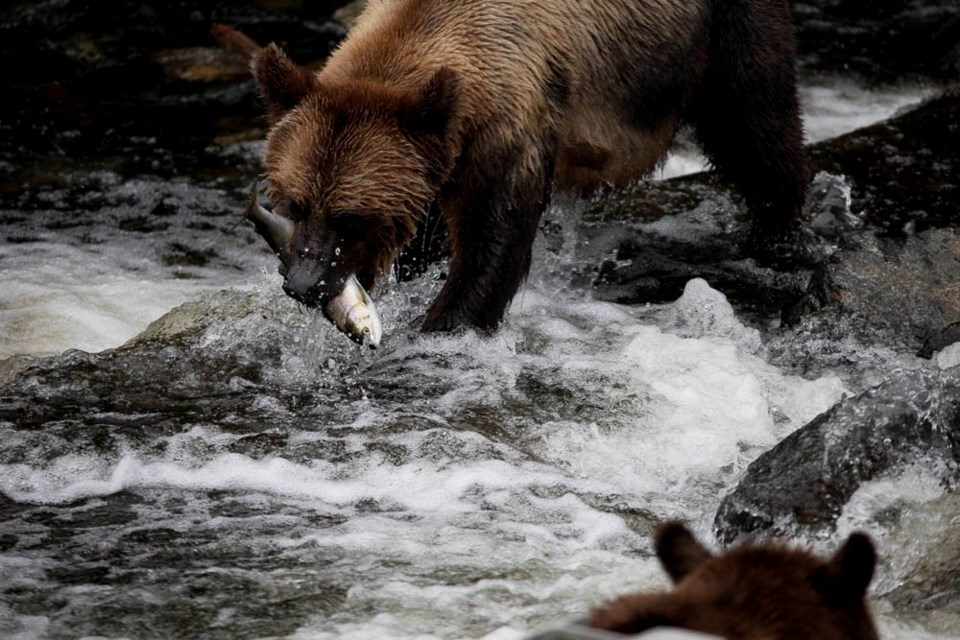Canada is wildlife central, and British Columbia arguably has the most diverse species on offer. Fall is a wonderful time to watch wildlife because it’s not too hot, the aspens have just started accenting the evergreen forest with yellow and gold, and the air takes on an inviting crispness. Just be sure to keep your distance from wildlife—30 m (98 ft) minimum and at least 100 m (328 ft) from predators like bears. Go early or at dusk when animals are the most active.
Ìý
Grizzlies on the Coast of the Great Bear Rainforest
Autumn is peak grizzly season, and fly-in , 80 km (50 mi) north of Campbell River,is a great place to see them. The Glendale Cove area has one of the largest concentrations of grizzly bears in BC, and the conservation-minded lodge focuses on safe viewing in the bears’ natural environment. You might see some of the 50 grizzly and black bears feasting on salmon within a 10-km (6-mi) radius of the floating wilderness resort, which is specially designed for optimal animal observation. You can also go sea kayaking along the pristine rainforest coast, take a marine wildlife tour, and whale watch until mid-October.
Ìý
Salmon in the Fraser River, near Vancouver
The story is iconic: wild salmon begin the arduous journey from the ocean back to where they were born, to spawn at the main stem of the Fraser Rivereach year from late September to early November. It’s one of the planet’s largest salmon runs. If you’ve never seen the battered, crimson-hued fish fighting their way upstream, especially when they get to the shallow northern streams at the end, it’s a stirring sight. And of course, the spent carcasses attract hungry bears, eagles, and gulls by the thousands. If you want to learn more, visit one of the Ìýnear Vancouver: Chilliwack River Hatchery, Abbotsford’s Fraser Valley Trout Hatchery(which also has steelhead and cutthroat), or the Capilano Salmon Hatcheryin North Vancouver.
Ìý
Bighorn Sheep in Radium Hot Springs,
You can see bighorn sheep in spring and summer in the Kootenay Rockies at , but the real drama unfolds in fall: rutting season, October into November. That’s when the rams of the 140-strong herd convene in town and start clashing, literally, for hours at a time in competition to win female attention. The 300-lb (140-kg) bachelors taunt, kick, and then charge each other at 35 kph (22 mph), rising on their hind legs to bash each other’s 30-lb (14-kg) horns with incredible force—you can hear the crack a mile away. In early November, there’s an annual two-day Headbanger Festivalwith tours and seminars. After the show, soak in Canada’s largest natural mineral hot springs.
Ìý
Moose in Prince George, Northern BC
Moose? You’ll want to head to Prince George, home to the highest density of these hooved giants in North America. In fact, 70% of the province’s moose live in Northern BC. Grown bulls with impressive sets of velvety antlers stand some 6.5-ft (2-m) tall and might weigh 1,100 lbs (500 kg). Late fall is rutting season when the usually solitary ungulates gather in groups of eight to 10 and lock horns. Listen for the cows’ loud, moaning call designed to lure a mate, and take care because moose can be aggressive at this time of year. Look in clearings and valleys as moose prefer open spaces with plenty of shrubs and brush to munch on and marshy areas surrounding lakes; they are easiest to find in the early morning. Try Highway 97 from Pine Pass to Old Friend Creek, or Highway 16 from Prince George to Valemount in the southern Rocky Mountain Trench. Another option is canoeing the Crooked River just north of town or in .Ìý



